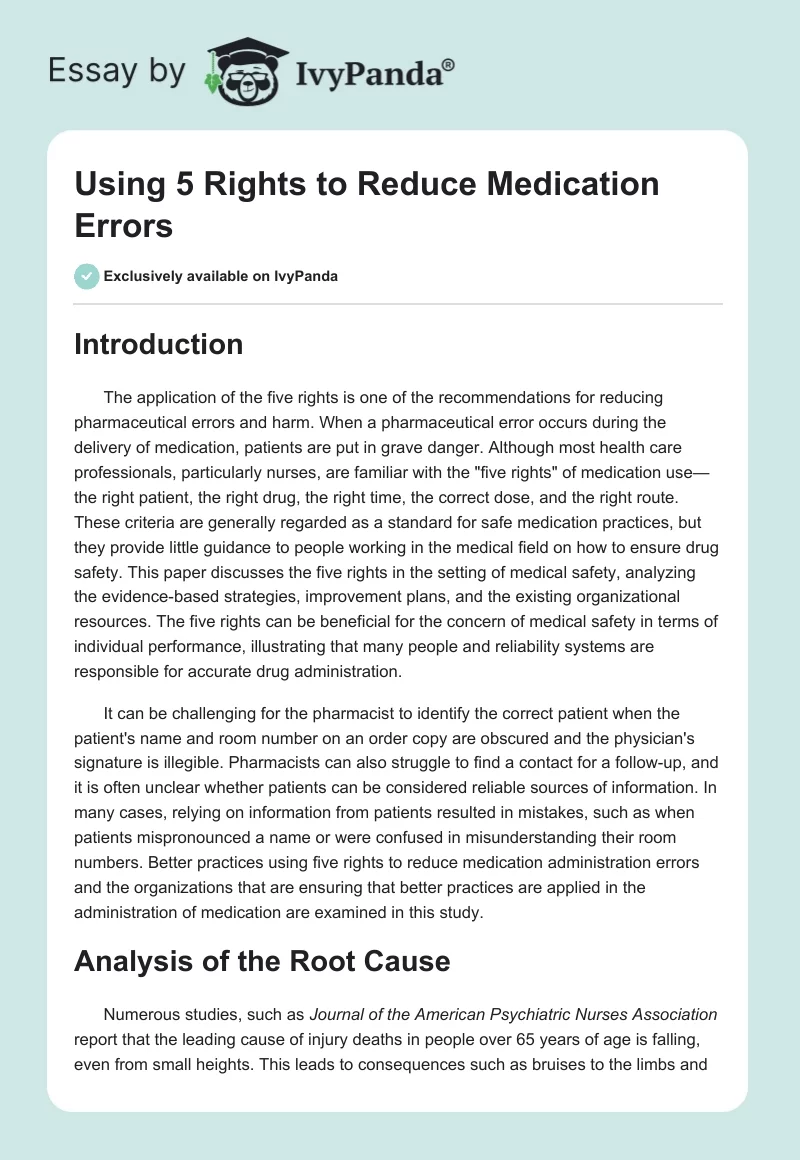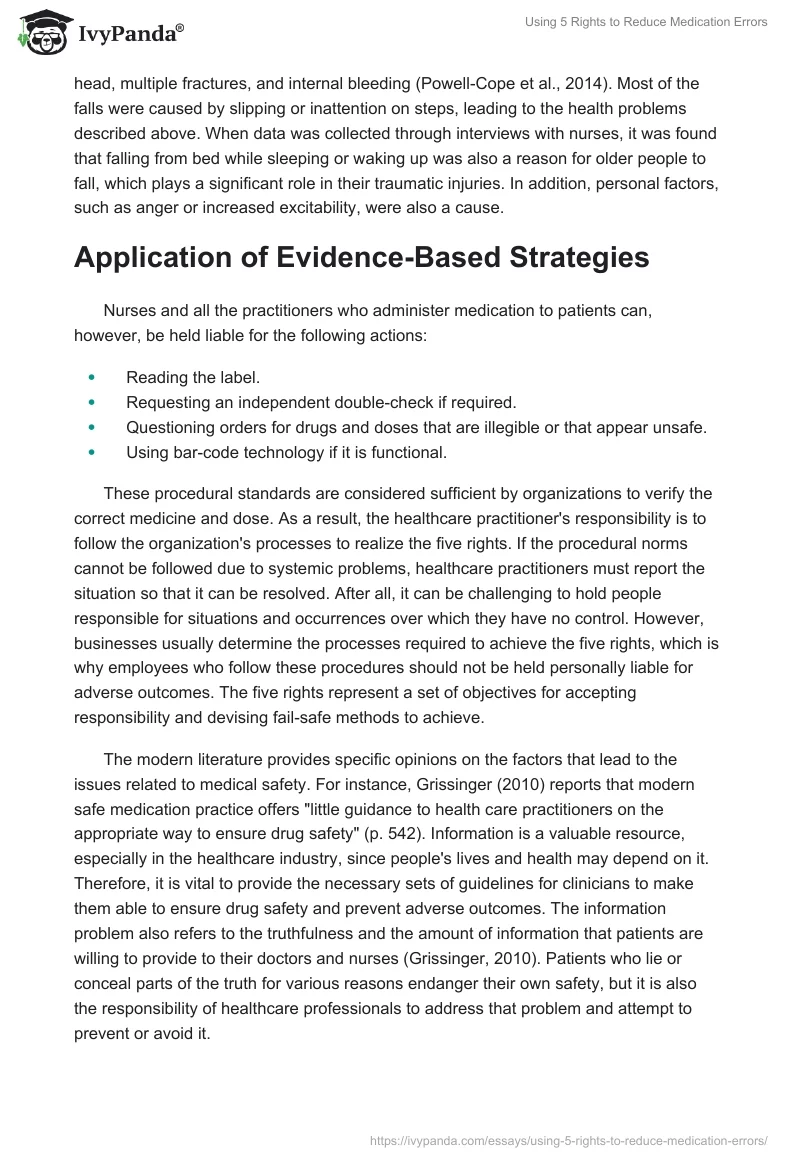Introduction
The application of the five rights is one of the recommendations for reducing pharmaceutical errors and harm. When a pharmaceutical error occurs during the delivery of medication, patients are put in grave danger. Although most health care professionals, particularly nurses, are familiar with the “five rights” of medication use—the right patient, the right drug, the right time, the correct dose, and the right route.
These criteria are generally regarded as a standard for safe medication practices, but they provide little guidance to people working in the medical field on how to ensure drug safety. This paper discusses the five rights in the setting of medical safety, analyzing the evidence-based strategies, improvement plans, and the existing organizational resources. The five rights can be beneficial for the concern of medical safety in terms of individual performance, illustrating that many people and reliability systems are responsible for accurate drug administration.
It can be challenging for the pharmacist to identify the correct patient when the patient’s name and room number on an order copy are obscured and the physician’s signature is illegible. Pharmacists can also struggle to find a contact for a follow-up, and it is often unclear whether patients can be considered reliable sources of information. In many cases, relying on information from patients resulted in mistakes, such as when patients mispronounced a name or were confused in misunderstanding their room numbers. Better practices using five rights to reduce medication administration errors and the organizations that are ensuring that better practices are applied in the administration of medication are examined in this study.
Analysis of the Root Cause
Numerous studies, such as the Journal of the American Psychiatric Nurses Association report that the leading cause of injury deaths in people over 65 years of age is falling, even from small heights. This leads to consequences such as bruises to the limbs and head, multiple fractures, and internal bleeding (Powell-Cope et al., 2014). Most of the falls were caused by slipping or inattention on steps, leading to the health problems described above. When data was collected through interviews with nurses, it was found that falling from bed while sleeping or waking up was also a reason for older people to fall, which plays a significant role in their traumatic injuries. In addition, personal factors, such as anger or increased excitability, were also a cause.
Application of Evidence-Based Strategies
Nurses and all the practitioners who administer medication to patients can, however, be held liable for the following actions:
- Reading the label.
- Requesting an independent double-check if required.
- Questioning orders for drugs and doses that are illegible or that appear unsafe.
- Using bar-code technology if it is functional.
These procedural standards are considered sufficient by organizations to verify the correct medicine and dose. As a result, the healthcare practitioner’s responsibility is to follow the organization’s processes to realize the five rights. If the procedural norms cannot be followed due to systemic problems, healthcare practitioners must report the situation so that it can be resolved. After all, it can be challenging to hold people responsible for situations and occurrences over which they have no control. However, businesses usually determine the processes required to achieve the five rights, which is why employees who follow these procedures should not be held personally liable for adverse outcomes. The five rights represent a set of objectives for accepting responsibility and devising fail-safe methods to achieve.
The modern literature provides specific opinions on the factors that lead to the issues related to medical safety. For instance, Grissinger (2010) reports that modern safe medication practice offers “little guidance to health care practitioners on the appropriate way to ensure drug safety” (p. 542). Information is a valuable resource, especially in the healthcare industry, since people’s lives and health may depend on it. Therefore, it is vital to provide the necessary sets of guidelines for clinicians to make them able to ensure drug safety and prevent adverse outcomes. The information problem also refers to the truthfulness and the amount of information that patients are willing to provide to their doctors and nurses (Grissinger, 2010). Patients who lie or conceal parts of the truth for various reasons endanger their own safety, but it is also the responsibility of healthcare professionals to address that problem and attempt to prevent or avoid it.
Improvement Plan with Evidence-Based and Best-Practice Strategies
As a first step toward enhancing medication safety, physicians and other healthcare providers must be knowledgeable about the medications available to treat their patients as a first step. There are numerous options for doing so, including Computerized Physician Order Entry (CPOE). When orders are organized directly within a computer system, their uniformity, legibility, and completion are ensured. CPOE should integrate clinical decision assistance to optimize its benefits. It can combine with clinical decision support systems (CDSS) to reduce errors related to medication (Kaushal & Bates, 2001).
In order to create case-specific advice, the system usually combines a medical knowledge base, patient data, and an inference engine (The American College of Obstetricians and Gynecologists, 2018). Patients must be involved in the drug ordering process, regardless of whether non-automated or automated technologies are employed. Clinicians should ensure that the patient is aware of the medical issue for prescribed medicine. The teach-back method can be used to determine retention and understanding of pharmaceutical usage by asking the patient to express their material in their own words back to the healthcare professional.
All medical team members, both in and out of the hospital, must work together to achieve positive outcomes. Oral communication or handouts explaining the use, dose, expected benefits, and probable side effects of the prescription are examples of such education. Patients should be given an adequate opportunity to ask questions and restate their grasp of proper medicine use to the clinician’s satisfaction (The American College of Obstetricians and Gynecologists, 2018). Allergies should be documented thoroughly and discussed with the patient. Furthermore, a list of any other medications the patient is currently taking should be recorded, and the patient should keep a copy for personal use and display it to healthcare providers at each visit. Extending this teaching to family members who will assist the patient with medication administration may help the patient use the drug correctly (Grissinger, 2010; Institute of Medicine, 2000; Kaushal & Bates, 2001).
Existing Organizational Resources
In healthcare systems worldwide, unsafe pharmaceutical practices and medication errors are the primary cause of injury and unnecessary harm. The annual cost of drug errors is estimated to be $42 billion worldwide. Errors can occur at any point during the medication administration process. Several strategies to reduce the frequency and severity of medication errors have been developed, but their implementation is inconsistent. World Health Organization (WHO) announced “Medication Without Harm” as the topic for the third Global Patient Safety Challenge to reduce severe, preventable medication-related harm by half in the next five years (World Health Organization, 2019). Below are some of the WHO’s Global Patient Safety Challenges:
- Safety of medications in high-risk scenarios;
- Polypharmacy medication safety;
- Medication safety during care transitions (National Quality Forum, 2011).
Although such organizations exist, they are not the most successful. The number of people suffering from illnesses is increasing every day. There should be several organizations to combat disease, as one is too few. There should be associations that aim to cure people of all races and nationalities. The WHO is an excellent alternative but not sufficient to achieve total disease control. Every country must join efforts to create one global health authority. At the moment there are developments in this plan, such as health ministries approaching a WHO, but this is not enough as there is no unity and such requests can cost the lives of many patients.
Conclusion
The five rights, of course, still seem to be developing and are not the final point in the world medicine structure. Managers frequently reprimand healthcare practitioners who violate the five rights without identifying or resolving the human reasons and causes of the system’s problem. Similarly, regulatory authorities frequently penalize healthcare practitioners who cannot verify the five rights, perpetuating the assumption that individuals are at fault. The five rights should be kept as medication-use objectives, but we must assist practitioners in achieving these objectives by developing robust support systems that promote safe practices (Grissinger, 2018).
Interruptions could cause medical errors, and it is critical for all team members to avoid or limit disruptions to the nurse preparing prescriptions or delivering medications (Cheragi et al., 2013). Methods for alerting colleagues not to interrupt healthcare providers while they are focused on tasks related to the preparation or administration of medications include no distraction zones (The American College of Obstetricians and Gynecologists, 2018). It is better not to disturb signs over medication preparation areas, and the use of colored vests worn by healthcare providers during the medication administration process.
References
Centers for Medicare and Medicaid Services. (2021).E-prescribing. CMS.
Cheragi, M. A., Manoocheri, H., Mohammadnejad, E., & Ehsani, S. R. (2013). Types and causes of medication errors from the nurse’s viewpoint.Iranian Journal of Nursing and Midwifery Research, 18(3), 228–231.
Grissinger M. (2010). The five rights: A destination without a map. Pharmacy and Therapeutics, 35(10), 542.
Institute of Medicine. (2000). To err is human: Building a safer health system. National Academies Press.
Kaushal, R., & Bates, D. W. (2001). Making health care safer: A critical analysis of patient safety practices.
National Quality Forum. (2011). Safe practices for better healthcare: 2010 update[Forum Project]. NQF.
Powell-Cope, G., Quigley, P., Besterman-Dahan, K., Smith, M., Stewart, J., Melillo, C., … Friedman, Y. (2014). A qualitative understanding of patient falls in inpatient mental health units.Journal of the American Psychiatric Nurses Association, 20(5), 328–339.
The American College of Obstetricians and Gynecologists. (2018). Committee on Patient Safety and Quality Improvement. Commitee Opinion, 531(331).
World Health Organization. (2019). Medication safety in key action areas. Web.


